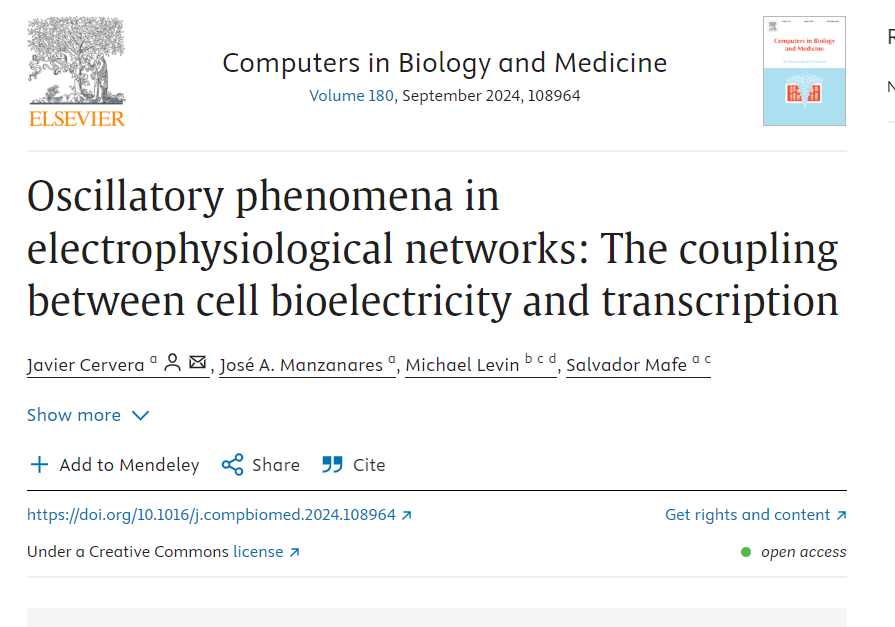Bioelectricity, the fundamental electrical processes within living organisms, is essential for communication, coordination, and various physiological functions. Recent research has highlighted the intricate coupling between bioelectricity and transcription, revealing how oscillatory phenomena in electrophysiological networks influence cell behavior and multicellular organization. However, external electromagnetic fields (EMFs), particularly those from artificial sources like radiofrequency radiation (RFR), can disrupt these bioelectric processes, leading to significant biological dissonances and adverse effects on health and development. This report explores the coupling between cell bioelectricity and transcription, the impact of external EMFs on these systems, and the broader implications for health and ecological balance.
Oscillatory Phenomena in Electrophysiological Networks
Oscillatory phenomena in electrophysiological networks_ The coupling between cell bioelectricity and transcription
Bioelectricity and Transcription
The study “Oscillatory phenomena in electrophysiological networks: The coupling between cell bioelectricity and transcription” investigates how bioelectrical and transcriptional oscillations interact at both the individual cell and multicellular levels. The researchers developed simulations based on ion channels and intercellular gap junctions to show that bioelectrical and transcriptional waves can couple distant regions of a network in phase and antiphase oscillatory states, leading to synchronization phenomena. This coupling allows cells to encode spatial and temporal information through oscillations between depolarized and polarized states, which are crucial for processes like embryogenesis, regeneration, and tumorigenesis.
Key Findings
- Bioelectrical Gradients: Bioelectrical gradients couple cell potentials to transcription rates, providing cells with spatial information within a multicellular aggregate. These gradients control local differentiation processes, switching on and off crucial parts of the genome.
- Oscillatory States: The simulations revealed that bioelectrical and transcriptional waves could synchronize distant regions of a model network, creating distinct oscillatory states that encode multicellular regionalization.
- Morphogenetic Regulation: The coupling between bioelectricity and transcription influences morphogenetic regulation during embryogenesis and regeneration, acting as a template for slow biochemical signals and guiding spatio-temporal coordination.
Effects of External EMFs on Bioelectric Systems
Disruption of Bioelectrical Oscillations
External EMFs, such as RFR from wireless technologies, can interfere with the natural bioelectrical oscillations within cells and tissues. These disruptions can lead to significant biological dissonances, affecting the organism’s ability to process and respond to environmental stimuli effectively. The interference of EMFs with bioelectrical processes can manifest in several ways:
- Altered Membrane Potentials: EMFs can disrupt the membrane potentials of cells, leading to abnormal depolarization or hyperpolarization. This disruption can affect the cell’s ability to maintain homeostasis and perform essential functions.
- Impaired Signal Transduction: The interference of EMFs with ion channels and gap junctions can impair signal transduction pathways, leading to altered gene expression and disrupted cellular communication.
- Oxidative Stress: EMFs can induce oxidative stress by generating reactive oxygen species (ROS), which can damage cellular components and disrupt bioelectrical signaling pathways.
Case Studies and Research Findings
- Nicotine Exposure and Bioelectrical Memory: Studies have shown that embryonic exposure to nicotine degrades bioelectrical memory patterns, leading to aberrant gene expression, brain morphology defects, and impaired learning. External interventions on bioelectric states, such as the transplantation of HCN2 channel tissue, have been shown to restore correct bioelectrical patterns and gene expression.
- TheraBionic Treatment: The FDA-approved TheraBionic treatment utilizes low-power RF radiation to treat inoperable liver cancer by inducing non-thermal interactions at the cellular level. This treatment highlights the potential for controlled EMFs to influence bioelectric processes positively, demonstrating the dual nature of EMFs as both harmful and therapeutic.
The Broader Implications for Health and Ecology
Ecological Impact of Artificial Light and EMFs
Artificial light and EMFs can have profound effects on natural ecosystems. For instance, a study published in Frontiers in Plant Science found that streetlights left on all night cause leaves to become so tough that insects cannot eat them, threatening the food chain. This phenomenon, driven by extended photosynthesis and increased leaf toughness, can disrupt ecological balance by reducing herbivory and affecting insect populations. The decline in herbivorous insects can cascade through the food chain, affecting predatory insects, insect-eating birds, and other wildlife.
Health Implications of EMF Exposure
Prolonged exposure to EMFs has been linked to various health issues, including sleep disturbances, increased stress levels, and potential carcinogenic effects. The disruption of circadian rhythms by artificial light can lead to chronic sleep deprivation and associated health problems. Similarly, EMF exposure can cause DNA damage, oxidative stress, and other cellular dysfunctions, contributing to conditions like cancer and neurodegenerative diseases.
Reinstating Research and Updating Regulations
Importance of Continued Research
To fully understand and mitigate the impact of external EMFs on bioelectric systems, continued research is essential. This includes studying the non-thermal effects of EMFs, exploring the mechanisms of bioelectrical disruption, and developing therapeutic applications that leverage controlled EMF exposure. Supporting and funding research initiatives like those conducted by the National Toxicology Program (NTP) and other scientific bodies is crucial for advancing our knowledge and developing effective interventions.
Regulatory Updates
Regulatory bodies, such as the Federal Communications Commission (FCC), must update their guidelines to reflect the latest scientific findings on EMF exposure. Current guidelines are often based on outdated research and do not account for the non-thermal effects of EMFs. By implementing stricter exposure limits and promoting safer wireless technologies, regulatory agencies can help protect public health and ensure ecological balance.
Conclusion
The intricate coupling between bioelectricity and transcription plays a vital role in the spatio-temporal coordination of cellular processes, essential for development and regeneration. However, external EMFs, particularly from artificial sources like RFR, can disrupt these bioelectrical processes, leading to significant biological dissonances and adverse health effects. Understanding the impact of EMFs on bioelectric systems and addressing the associated risks through continued research and updated regulations is crucial for preserving both human health and ecological balance. By exploring the dual nature of EMFs as both harmful and therapeutic, we can develop strategies to mitigate their negative effects and harness their potential for medical applications.








